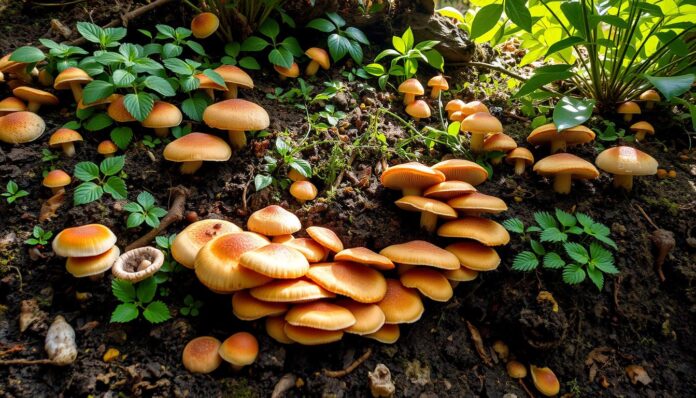What if the key to sustainable agriculture and ecosystem health lay in the humblest of organisms – fungi? Mycology, the study of fungi, is crucial in permaculture. This design system aims to create sustainable and regenerative ecosystems. Fungi are vital for ecosystems, making them perfect for permaculture, including mycology and sustainable agriculture. We will explore how mycology is key in permaculture, its benefits, and how to cultivate fungi.
Exploring permaculture mycology reveals the complex relationships between fungi, plants, and the environment. From growing edible mushrooms to using mycorrhizal fungi for soil cleanup, fungi’s uses in permaculture are wide-ranging. Experts like Michael Weese, with 29 years of experience, help us understand fungi’s role in sustainable agriculture and ecosystem health.
Key Takeaways
- Permaculture mycology is a vital component of sustainable agriculture and ecosystem health
- Fungi have unique characteristics that make them ideal for permaculture applications, including fungi cultivation
- Mycorrhizal fungi can be used for soil remediation and to enhance plant growth
- Edible mushrooms can be cultivated using sustainable methods, such as inoculating logs with mushroom spawn
- Medicinal mushrooms have been used for centuries to enhance immune function and address mental health challenges
- Permaculture mycology can help increase productivity sustainably, while decreasing plastic waste and promoting sustainable agriculture
- Fungi can play a crucial role in ecosystem health, from removing pollutants to enhancing soil fertility
Understanding Permaculture Principles
Permaculture is a design system that aims to create sustainable ecosystems. Ben Falk says it’s about making a positive impact on the environment. This is key for eco-friendly farming and organic gardening, fostering a good relationship between plants, animals, and microorganisms.
Defining Permaculture
Permaculture is built on three main ethics: earth care, people care, and fair share. These guide the design of permaculture systems. They ensure systems are good for the environment, fair for people, and work economically. The mycorrhizal network is vital, helping plants and fungi share nutrients for healthy ecosystems.
Core Ethics of Permaculture
The core ethics of permaculture are key to a sustainable system. By following these, people can create eco-friendly farming and organic gardening that support biodiversity and local communities. The mycorrhizal network helps plants get nutrients and water, reducing the need for outside help.
Designing with Nature in Mind
Permaculture design works with nature, not against it. By copying natural patterns, people can build organic gardening systems that are strong, diverse, and productive. The mycorrhizal network is crucial, helping plants and fungi share nutrients for a balanced ecosystem.
The Role of Mycology in Ecosystems
Mycology is key to keeping soil healthy, which is vital for our planet. Fungi, like mushrooms, break down organic matter and recycle nutrients. This makes them essential in permaculture systems. The Fungi Academy says mushrooms are great for permaculture, helping clean pollution, improve soil, and offer food and medicine.
Importance of Fungi in Soil Health
Fungi are crucial for soil health. They break down organic matter and recycle nutrients. This boosts soil fertility, helping plants grow better. Some benefits of fungi in soil include:
* Better nutrient cycling
* Improved soil structure
* More soil biodiversity
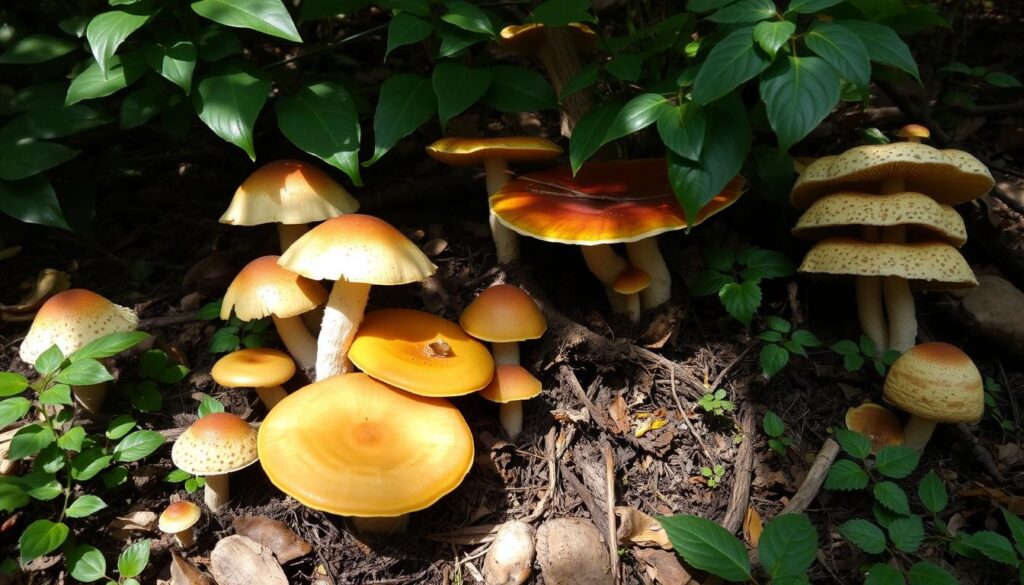
Interactions Between Plants and Fungi
Fungi and plants work together, forming beneficial relationships. Fungi get carbs from plants, while plants get vital nutrients from fungi. This teamwork is important for environmental care, helping plants grow strong and reducing the need for harmful fertilizers.
| Benefits of Fungi-Plant Interactions | Description |
|---|---|
| Improved Plant Growth | Fungi provide essential nutrients to plants, promoting healthy growth and development. |
| Increased Soil Biodiversity | Fungi help to break down organic matter, increasing soil biodiversity and promoting a healthy ecosystem. |
Types of Fungi Beneficial for Permaculture
Fungi are key in permaculture, offering many benefits for organic gardening and mycorrhizal network growth. They form special bonds with plants, boosting their health and growth. Fungi cultivation adds value to permaculture, providing food and income.
Urban Farmer Buttons Testa highlights oyster mushrooms as a prime example. They can grow on over 10 substrates, like corn stalks and paper. This makes them a reliable food source and income generator.
- Edible fungi, such as oyster mushrooms and shiitake
- Medicinal fungi, such as reishi and cordyceps
- Mycorrhizal fungi, such as mycelium, which form symbiotic relationships with plants
These fungi serve many purposes, from food and income to improving plant health. By adding them to permaculture, we can build more sustainable and varied ecosystems.
Soil Health and Mycelium
Mycelium is key to soil health, acting as a natural filter. It breaks down pollutants and recycles nutrients. This is vital for environmental stewardship, keeping ecosystems balanced and sustainable. For mushroom cultivation, knowing how mycelium affects soil health is crucial.
The Fungi Academy says mycelium filters pollutants from soil and water. This improves ecosystem health and sustainability. By adding mushroom cultivation to permaculture, we can help soil health. This also supports a greener environment.
- Enhancing soil fertility through nutrient recycling
- Forming networks that connect plants and promote ecosystem health
- Contributing to the breakdown of pollutants and toxins
Mycelium’s role in soil health and environmental stewardship is huge. It supports sustainable mushroom cultivation practices.
Cultivating Fungi in Permaculture Systems
Cultivating fungi is key in permaculture. It boosts soil health and adds to biodiversity. The right species, techniques, and seasonal timing are crucial. The Fungi Academy says picking the right species is essential because each fungus has its own needs.
Choosing the Right Species
Choosing the right fungi species is vital. Each species needs different conditions and offers unique benefits. Some are better for organic gardening, while others are ideal for mushroom growing. Knowing what each species needs is key to success.
Techniques for Cultivation
There are specific techniques for growing fungi, like inoculation and incubation. These need careful handling for growth. Fungi also play a big role in organic gardening. By using fungi, gardeners can improve soil health and create a better ecosystem.
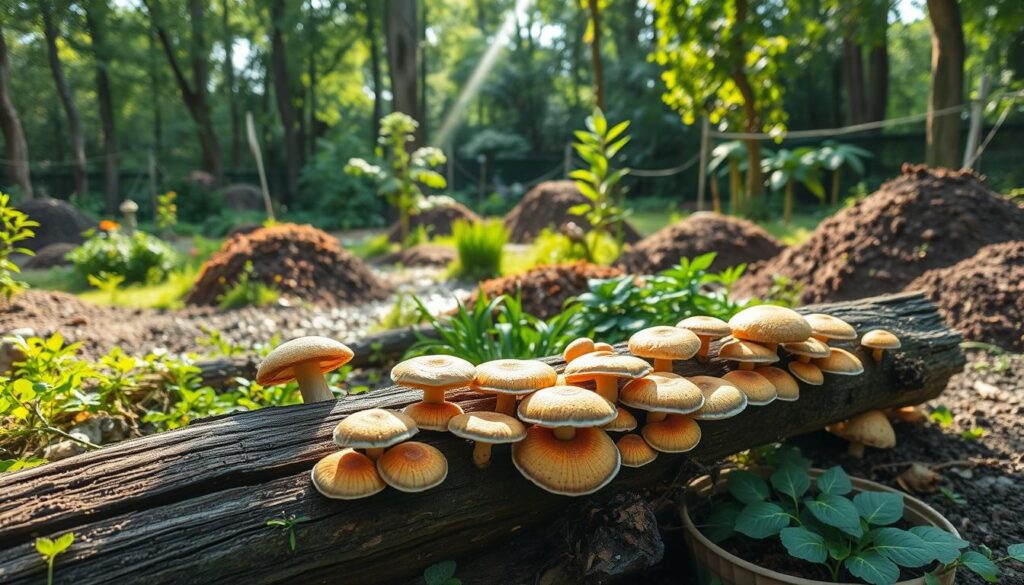
Seasonal Considerations for Growth
Seasons affect fungi growth. Temperature and humidity are important for optimal growth. Knowing these seasonal factors helps in growing fungi successfully. This is true for both mushroom growing and organic gardening.
| Species | Optimal Temperature | Optimal Humidity |
|---|---|---|
| Oyster Mushrooms | 55-60°F | 70-80% |
| Shiitake Mushrooms | 50-55°F | 60-70% |
By considering these factors and using the right techniques, people can grow fungi well. This helps make permaculture systems more sustainable and diverse. It’s all about effective fungi cultivation and organic gardening.
Fungi in Composting Processes
Fungi are key in composting, speeding up the breakdown of organic matter. They help recycle nutrients, making soil healthier. This is vital for taking care of our environment and growing plants sustainably.
Mushroom cultivation is a part of using fungi in composting. Adding mushroom spawn to compost piles makes the soil better for plants. This method also cuts down on the need for harmful fertilizers, helping the planet.
Using fungi in composting has many benefits. It improves soil health and speeds up decomposition. This helps reduce waste and supports sustainable gardening. It also helps plants grow well by making the soil rich in nutrients.
| Substrate | Mushroom Species | Decomposition Rate |
|---|---|---|
| Corn stalks | Oyster mushrooms | High |
| Wheat straw | King Stropharia | Medium |
| Rice straw | Shiitake mushrooms | Low |
By using fungi in composting, gardeners can make their waste management more sustainable. This method supports environmental care and helps plants grow strong through mushroom cultivation.
Integrating Fungal Systems into Gardens
Organic gardening aims to create a balanced ecosystem. One way to do this is by adding fungal systems to gardens. This can be achieved through companion planting with fungi, creating habitats for them, and using fungi in raised beds and containers. Such actions can boost plant growth and health, and also offer a sustainable food and medicine source.
Companion Planting with Fungi
Companion planting with fungi means growing fungi alongside vegetables or other plants. For instance, growing mushroom cultivation species with vegetables can increase their yield and disease resistance. This is because fungi can connect with plant roots through a mycorrhizal network, offering vital nutrients and water.
Creating Fungal Habitats
To create fungal habitats, gardeners need to provide a suitable environment for fungi to thrive. This can be achieved by setting up a mycorrhizal network of fungi and plants or using organic gardening methods. Doing so not only offers a sustainable food and medicine source but also boosts garden health and biodiversity.
Fungi in Raised Beds and Containers
Fungi can also be used in raised beds and containers for efficient and productive mushroom growth. Adding fungi-rich soil or compost to these spaces and then planting desired species can enhance plant health. This method also provides a sustainable food and medicine source.
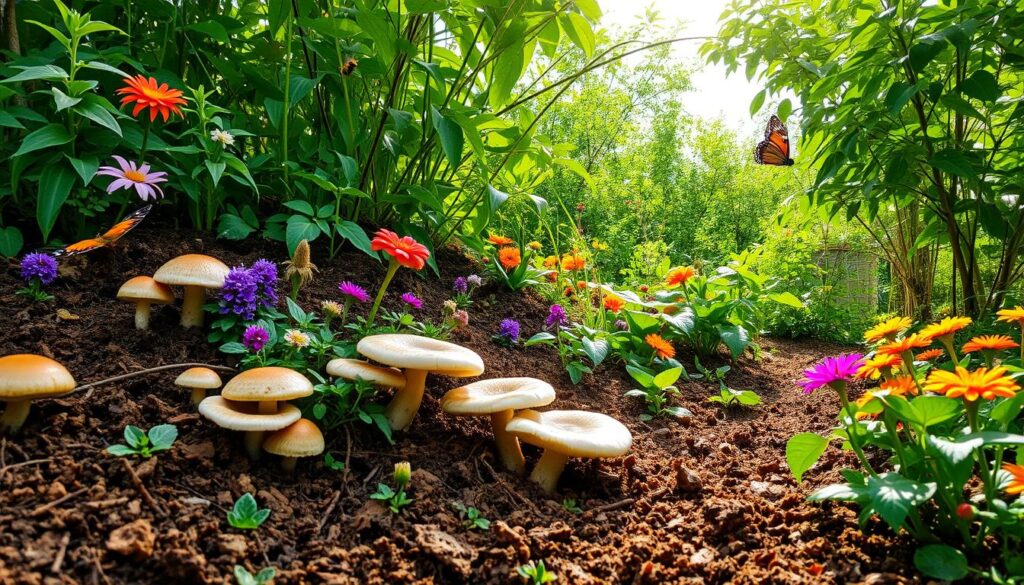
| Fungal Species | Benefits |
|---|---|
| Mushroom cultivation | Enhances plant growth and health |
| Mycorrhizal network | Provides essential nutrients and water to plants |
| Organic gardening | Creates a balanced ecosystem and provides a sustainable source of food and medicine |
The Symbiotic Relationship with Plants
Fungi and plants have a special relationship where both benefit. This is called a mycorrhizal association. In this, fungi connect with plant roots, helping them grow and stay healthy. The Fungi Academy says this connection boosts nutrient uptake and disease resistance.
This makes fungi key to soil health and caring for our environment.
Some key benefits of this relationship include:
- Increased nutrient uptake: Mycorrhizal fungi help plants get nutrients they can’t reach on their own. This improves their health and growth.
- Improved resistance to disease: These fungi protect plants from harmful pathogens. This means we use fewer chemicals.
- Enhanced soil health: Mycorrhizal fungi also make the soil better for plants. They improve its structure, air, and carbon storage.
By supporting mycorrhizal associations, we can make our soil healthier. This helps the environment and supports sustainable farming.
| Benefits of Mycorrhizal Associations | Description |
|---|---|
| Increased Nutrient Uptake | Mycorrhizal fungi help plants access nutrients that would be hard to reach. |
| Improved Resistance to Disease | Mycorrhizal fungi protect plants from harmful pathogens, cutting down on chemical use. |
| Enhanced Soil Health | Mycorrhizal fungi improve soil’s structure, air, and carbon storage, helping plants grow better. |
Identifying and Harvesting Wild Fungi
When we talk about finding and picking wild fungi, safety and care for the environment are key. The Fungi Academy says we must think carefully about these things. This is very important for organic gardening and environmental stewardship. We want to keep our ecosystems healthy and balanced.
In mushroom cultivation, knowing the risks of wild fungi is crucial. About 2% of mushrooms in North America can be deadly. The Death Cap and Destroying Angels are examples of deadly mushrooms found here. To pick safely, we need to use field guides and know about lookalike mushrooms.
Safety and Identification Tips
For safe picking, pay attention to the environment and the trees around. Most mushrooms grow with certain trees. Also, a mushroom’s look can help us identify it. Knowing how gills and stems connect is also important.
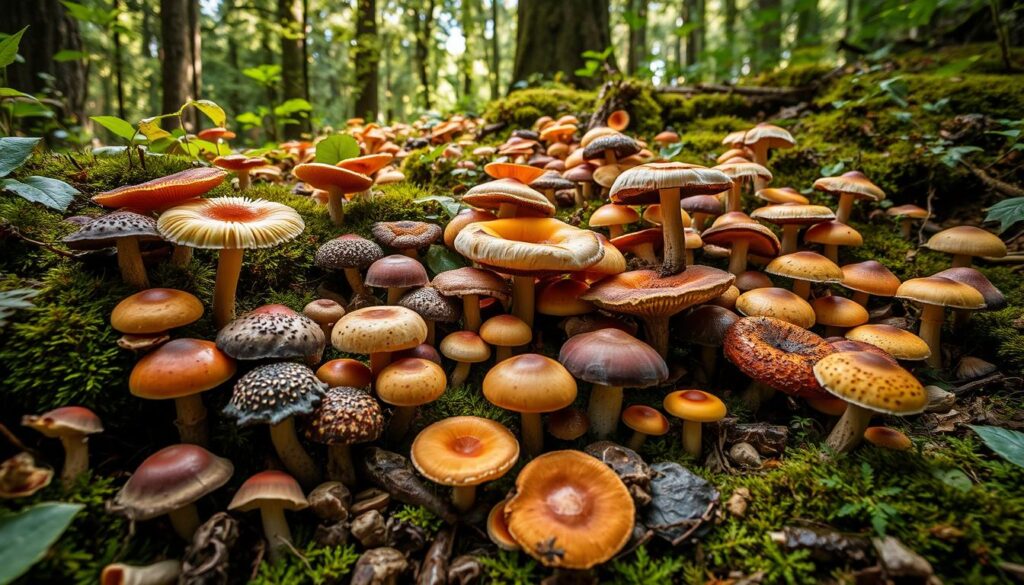
Sustainable Harvesting Practices
To help the environment and keep wild fungi around for a long time, we must harvest sustainably. This means only taking what we need and leaving some for others. We should also think about how our actions might affect the ecosystem.
The Impact of Fungal Diversity on Ecosystems
Fungal diversity is key to keeping ecosystems healthy and sustainable. The Fungi Academy says different fungi species play unique roles. They help with soil health and boost biodiversity. A study by mycologists shows how vital fungal diversity is for ecosystem balance.
Climate change and habitat loss can harm ecosystems. But, environmental stewardship efforts can help. These include conservation and using land wisely. The mycorrhizal network is crucial, linking fungi and plants to improve nutrient sharing.
Some main benefits of fungal diversity are:
- Enhanced ecosystem resilience
- Increased plant diversity and productivity
- Improved soil fertility and structure
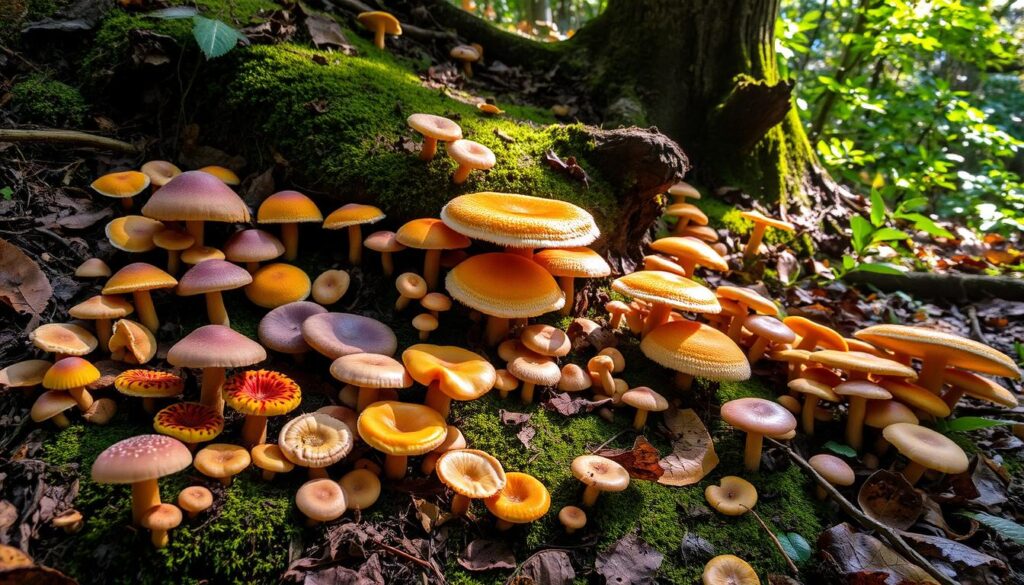
By supporting fungal diversity and environmental stewardship, we can keep ecosystems healthy. This is done through sustainable land use, conservation, and understanding fungi, plants, and their environments.
| Fungal Diversity Benefits | Description |
|---|---|
| Enhanced Ecosystem Resilience | Increased ability of ecosystems to withstand disturbances |
| Increased Plant Diversity and Productivity | Improved plant growth and diversity due to fungal symbiosis |
| Improved Soil Fertility and Structure | Enhanced soil health through fungal decomposition and nutrient cycling |
Fungal Diseases and Their Management
Fungal diseases can harm ecosystem health a lot. It’s key to prevent and control them. The Fungi Academy says keeping soil health good is vital to stop fungal diseases. By using environmental stewardship practices, we can lower the risk of fungal diseases in our gardens.
Common fungal diseases in gardens are powdery mildew and root rot. We can manage these with crop rotation and biological control. Mushroom cultivation, like King Stropharia, helps keep the ecosystem balanced and improves soil health.
Preventing and controlling diseases is crucial. Using fungicides and practicing good hygiene helps. But, we must remember the importance of fungal balance and its impact on the ecosystem. By managing fungal diseases holistically, we support environmental stewardship and keep ecosystems healthy.
Mycology Research in Permaculture
Mycology research is key to understanding fungi and their role in ecosystems. New methods like molecular techniques and studying fungal ecology are giving us fresh insights. Fungi cultivation is vital in permaculture, supporting organic gardening and environmental stewardship.
There are many ways fungi are being used, like in bioremediation and agriculture. For instance, some fungi can clean pollutants from soil and water. Others help make soil more fertile. Here are some examples:
- Using fungi to break down organic matter and create nutrient-rich compost
- Implementing mycofiltration systems to remove pollutants from water
- Cultivating edible fungi, such as oyster mushrooms, for food and income
Looking at successful cases of fungi use in permaculture can teach us a lot. By using these methods, we can help the environment and work towards a greener future.
| Practice | Benefits |
|---|---|
| Fungi cultivation | Promotes organic gardening and environmental stewardship |
| Mycofiltration | Removes pollutants from water and improves water quality |
| Edible fungi cultivation | Provides a source of food and income |
Educational Resources and Communities
For those into organic gardening and mushroom cultivation, many resources and communities exist. The Fungi Academy says these are key for learning about fungi and their role in nature.
Books and online guides give insights into fungal biology and ecology. Local groups, like mycology clubs and permaculture groups, offer hands-on learning and networking. These groups help people understand the mycorrhizal network and its role in organic gardening.
Online Platforms and Workshops
Instagram and YouTube have fueled interest in mycology. Workshops and festivals, like Mycofest, let people share knowledge and experiences. These events help individuals become mycology experts, like William Padilla-Brown, who became an expert in five years through books and workshops.
Networking and Community
Online forums and social media help people connect and support each other. This is great for those into mushroom cultivation and organic gardening. They can exchange tips and learn from others. Connecting with others deepens understanding of the mycorrhizal network and its ecosystem role.
Sustainable Practices with Fungi
Environmental stewardship is key in mushroom cultivation. It protects ecosystems and ensures fungi are harvested right. The Fungi Academy says using sustainable practices keeps soil health good and supports biodiversity. By only taking what we need and leaving some for others, we help keep ecosystems balanced.
Organic farming with fungi uses natural materials and cuts down on waste. It’s a green way to get fungi. For instance, using fungi to break down organic waste helps ecosystems. Mushroom cultivation can also lessen agricultural waste and improve soil.
Benefits of Sustainable Fungal Practices
- Improved soil health through the use of mycorrhizal fungi
- Increased biodiversity through responsible foraging and farming practices
- Reduced waste and pollution through the recycling of organic matter
Using sustainable methods with fungi helps our environment. It keeps ecosystems healthy. This way, we also help make farming more eco-friendly, cutting down on harmful chemicals.
| Practice | Benefit |
|---|---|
| Responsible foraging | Promotes biodiversity and preserves ecosystem balance |
| Organic fungal farming | Provides a sustainable source of fungi and reduces waste |
| Recycling organic waste | Reduces pollution and promotes soil health |
The Future of Mycology in Permaculture
Looking ahead, fungi cultivation will be key in making farming more sustainable. More farmers and gardeners are turning to permaculture. They see the value in using fungi to make soil better and grow more food.
New trends in mycology include using fungi to clean up polluted areas. Mycoremediation helps fix damaged ecosystems, like after wildfires or oil spills. Myco-permaculture combines permaculture with fungal biology for better farming.
Integrating fungi into permaculture brings many benefits. These include:
- Soil health gets a boost from mycelium networks
- Crops grow better thanks to fungi
- It’s good for the environment
As we learn more about fungi in permaculture, we’ll move towards greener farming. By focusing on fungi cultivation and organic gardening, we can make permaculture the standard. This way, taking care of the environment will always be a priority.
| Practice | Benefits |
|---|---|
| Mycoremediation | Restores ecologically damaged areas |
| Myco-permaculture | Emphasizes sustainable agriculture techniques |
| Organic gardening | Improves soil health and increases crop yields |
Conclusion: The Importance of Integrating Mycology
The use of permaculture mycology is key for creating sustainable ecosystems. We’ve learned how fungi improve soil health and help nutrients cycle. This makes ecosystems stronger and more resilient.
Mycorrhizal fungi play a big role in how plants and fungi work together. Fungi are also great at breaking down organic matter and cleaning pollutants. By growing fungi in our permaculture, we gain many benefits for our ecosystems.
Looking ahead, we need more research and teaching about mycology. By learning about fungi, we can help make farming more sustainable. This knowledge will help us create a healthier world. It’s time to start using fungi in our permaculture efforts.

